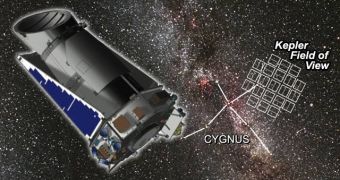Designed specifically to peer into the heart of distant star systems inside the Milky Way, the Kepler Space Telescope (KST) has a huge task ahead of it, namely to find Earth-like planets that may be lurking in the deep recesses of space, or which are too small to be identified using existing telescopes. Launched on March 6th, the instrument has thus far spent its time calibrating its highly sensitive instruments and ensuring that the light that entered its lenses at launch did not affect any of its delicate sensors or circuitry.
Now that the tests are complete, mission controllers are excited to announce the inception of real scientific observations with the new observatory. For the next three-and-a-half years, the telescope will move around the Sun in an Earth-trailing orbit, and will analyze light coming from more than 100,000 stars that have been especially selected for this mission. The astronomers who established Kepler's targets said that these stellar formations held the greatest chances of actually having Earth-like planets orbiting them. As far as sizes and magnitudes go, they are roughly similar to the Sun, which makes them a prime target for this type of observations.
“Now the fun begins. We are all really excited to start sorting through the data and discovering the planets,” Ames Research Center Kepler Science Principal Investigator William Borucki, from the facility's headquarters, in Moffett Field, California, said. NASA also announced that the first list of targets had already been completed by mission controllers, and that the data had already been uploaded and programmed into the telescope's computerized “brain.”
“If Kepler got into a staring contest, it would win. The spacecraft is ready to stare intently at the same stars for several years so that it can precisely measure the slightest changes in their brightness caused by planets,” Kepler Project Manager at the Jet Propulsion Laboratory James Fanson, from the lab's headquarters, in Pasadena, California, added. Discovering planets as small as the Earth around very distant stars is very tricky, as the observatory performing the measurements needs to be extremely accurate.
It has to record very slight and tiny variations in the star's luminosity, which could, in turn, imply that a planet, moon, or asteroid has moved between it and the telescope. But a planet could take several Earth years to orbit its star, therefore any telescope observing a certain region would need to continuously peer at it, in order to ensure that what it has discovered is a planet, and not just some random celestial body just happening to pass by.

 14 DAY TRIAL //
14 DAY TRIAL //